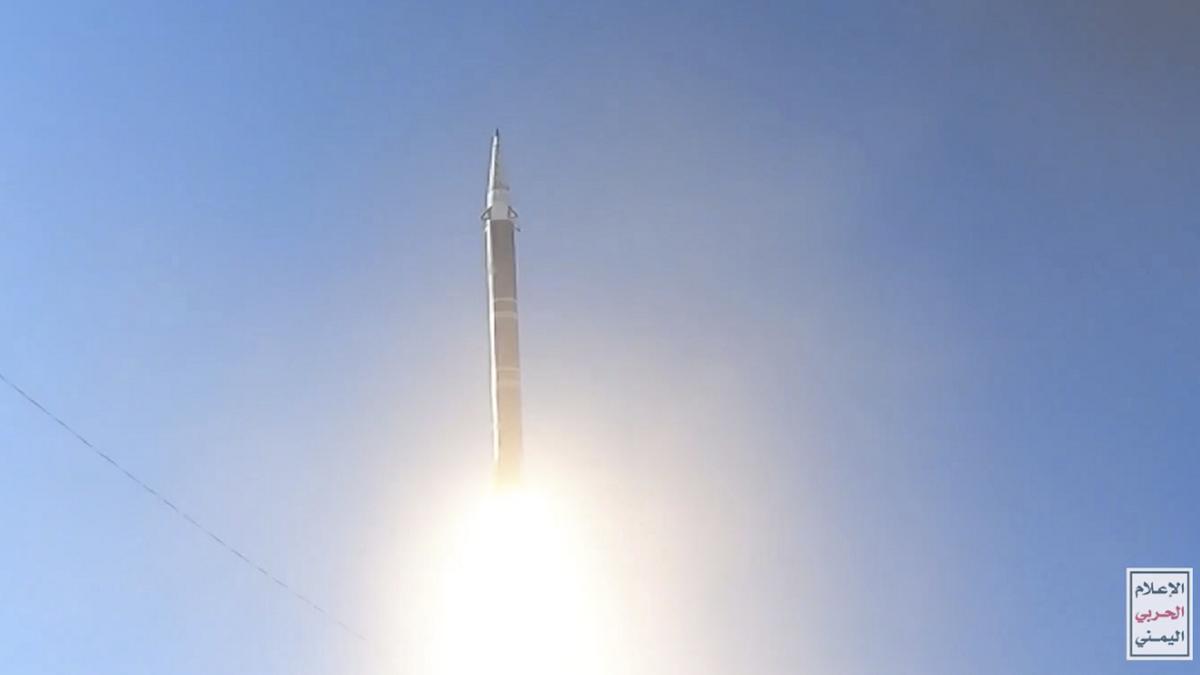Yemen’s Houthi rebels have showcased a new solid-fuel missile in their arsenal that bears similarities to an earlier model displayed by Iran, which was touted as capable of hypersonic speeds.
The rebels test-fired their latest “Palestine” missile, featuring a warhead painted in the style of a Palestinian keffiyeh checkered scarf, towards the Israeli port of Eilat on Monday. Despite triggering air raid sirens, the attack did not result in any reported damage or casualties.
Video footage released by the Houthis depicted the launching of the Palestine missile from what appeared to be a mobile platform, soaring rapidly into the sky with white smoke billowing from its engine – a characteristic feature of solid-fuel missiles.
Also read: Who are Yemen’s Houthis? | Explained
Solid-fuel missiles offer the advantage of quicker setup and firing compared to liquid-fuel missiles, which is crucial for the Houthis as their launch sites have been targeted by U.S. and allied forces due to the rebels’ assaults on shipping in the Red Sea region. One such strike hit the Houthis before they could launch their missile.
The Houthis claimed the Palestine missile to be of local origin. However, given Yemen’s limited resources and technological capabilities, it is improbable that they independently developed complex missile and guidance systems. The Houthis have been consistently supplied with arms by Iran despite a U.N. embargo on arms transfers.
Iranian media reported the missile launch and attributed the production to local sources, citing the Houthis. Nevertheless, design features of the Palestine missile bear resemblance to other missile models developed by Iran’s Revolutionary Guard, such as the Fattah, known for its hypersonic capabilities.
Iran had introduced the Fattah missile last year, claiming it could reach speeds of Mach 15 and had a range of up to 1,400 kilometers. While this falls slightly short of the distance to Eilat from Houthi-controlled areas in Yemen, adjustments can be made to extend the missile’s range.
In March, reports surfaced that the Houthis possessed a hypersonic missile, indicating advancements in their weaponry. A missile expert from the International Institute for Strategic Studies suggested that the Palestine missile is likely an advanced, precision-guided solid propellant missile provided by Iran.
Iran’s mission to the United Nations denied any violations of U.N. resolutions regarding arms transfers and emphasized the Houthi’s military capabilities as a result of internal development.
Hypersonic weapons, flying at speeds exceeding Mach 5, present challenges to traditional missile defense systems due to their speed and agility, making interception more difficult.
China and the U.S. are known to be pursuing hypersonic technology, with Russia claiming to have already deployed such weapons. The maneuverability and speed of the Palestine missile remain uncertain.
Meanwhile, reports emerged of explosions near a commercial ship in the southern Red Sea, close to the Bab el-Mandeb Strait. Though no injuries were reported, suspicions pointed to the Houthis as the likely perpetrators. The U.S. Central Command confirmed a ballistic missile launch by the Houthis into the Red Sea, followed by the interception of drones and drone boats by American and allied forces.
“No injuries or damage were reported by U.S., coalition, or commercial vessels,” stated the Central Command.








































